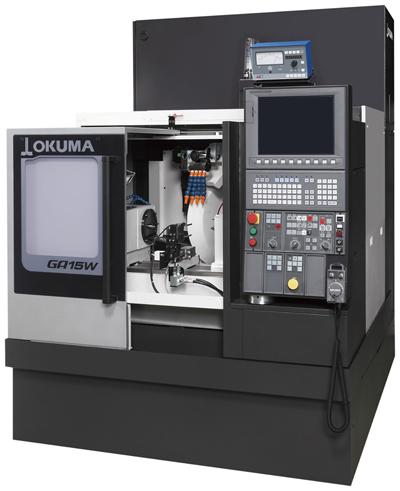
Okuma's GPW/GAW grinder series is now equipped with the intelligent OSP-P300G CNC. Okuma's open architecture OSP-P control runs on a Windows-based platform and fully integrates the machine, motors, drives and encoders, allowing for enhanced machine performance and true customization to suit particular machining needs. The Easy Operation control and touch screen increase efficiency by letting users easily and quickly toggle between machine operations, programming and wheel preparation screens.
The innovative wheelhead traverse structure gives these grinders a solid, compact footprint that saves valuable machine floor space while the user-friendly design allows various workpieces to be loaded effortlessly for easy automation in high production environments. The extremely rigid foundation allows for heavy-duty cutting and high speed grinding of 5.5kW with an optional 7.5kW.
The series is equipped with standard Chatter Control function that automatically adjusts wheel speed for accurate, stable machining. The high-speed grinding wheel spindle is ideal for cutting mass produced small parts with precision. Included in this grinder series are the GP14W, 15W, GA14W and 15W.
Key features of the GPW/GAW series:
• OSP-P300G control
• Dead center workhead (Std: C type)
• Chucking headstock (T specs standard) Tailstock quill stroke 35mm
• Wheel spindle motor: 5.5 kW (10 hp) (inverter drive)
• High feed rates X-axis ø30 m/min.; Z-axis: 20 m/min.
• uperior rigidity for powerful grinding
• Variety of loader patterns for easy automation
Contact Details
Related Glossary Terms
- chatter
chatter
Condition of vibration involving the machine, workpiece and cutting tool. Once this condition arises, it is often self-sustaining until the problem is corrected. Chatter can be identified when lines or grooves appear at regular intervals in the workpiece. These lines or grooves are caused by the teeth of the cutter as they vibrate in and out of the workpiece and their spacing depends on the frequency of vibration.
- computer numerical control ( CNC)
computer numerical control ( CNC)
Microprocessor-based controller dedicated to a machine tool that permits the creation or modification of parts. Programmed numerical control activates the machine’s servos and spindle drives and controls the various machining operations. See DNC, direct numerical control; NC, numerical control.
- feed
feed
Rate of change of position of the tool as a whole, relative to the workpiece while cutting.
- grinding
grinding
Machining operation in which material is removed from the workpiece by a powered abrasive wheel, stone, belt, paste, sheet, compound, slurry, etc. Takes various forms: surface grinding (creates flat and/or squared surfaces); cylindrical grinding (for external cylindrical and tapered shapes, fillets, undercuts, etc.); centerless grinding; chamfering; thread and form grinding; tool and cutter grinding; offhand grinding; lapping and polishing (grinding with extremely fine grits to create ultrasmooth surfaces); honing; and disc grinding.
- grinding wheel
grinding wheel
Wheel formed from abrasive material mixed in a suitable matrix. Takes a variety of shapes but falls into two basic categories: one that cuts on its periphery, as in reciprocating grinding, and one that cuts on its side or face, as in tool and cutter grinding.

